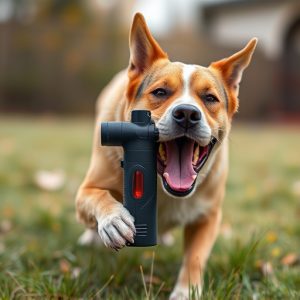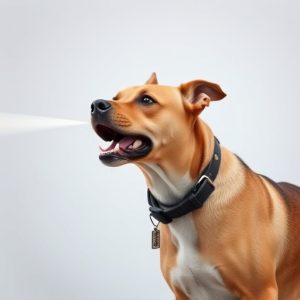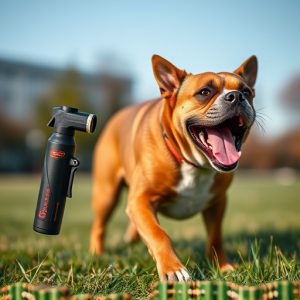Mastering Pepper Spray Dog Defense Drills: Effectiveness and Safety Guide
TL;DR:Pepper spray, using capsaicin as its active ingredient, is a powerful yet non-lethal tool for…….
TL;DR:
Pepper spray, using capsaicin as its active ingredient, is a powerful yet non-lethal tool for controlling aggressive dogs. Its effectiveness hinges on proper training, ventilation, and safety protocols, with regular maintenance and correct storage crucial for longevity. Recommended ranges for general and advanced training are 3-5 meters (10-16 feet) and 7-10 meters (23-33 feet), respectively. Structured training involving understanding spray mechanics, practical drills in controlled environments, and simulating aggressive encounters from various angles ensures safe and effective Effective Pepper Spray Dog Defense Drills.
“Discover the power of pepper spray as a tool in animal control and dog defense drills. This comprehensive guide explores its effectiveness, safety precautions, and how to choose the ideal range for optimal training results. From understanding the science behind pepper spray to implementing tactical steps, learn how this versatile tool can enhance your ability to manage and protect against aggressive animals. Mastering Effective Pepper Spray Dog Defense Drills has never been more accessible.”
- Understanding Pepper Spray for Animal Control: Its Effectiveness and Safety Precautions
- Choosing the Right Pepper Spray Range for Dog Defense Drills
- Implementing Pepper Spray Tactics: Step-by-Step Guide for Effective Training
Understanding Pepper Spray for Animal Control: Its Effectiveness and Safety Precautions
Pepper spray has emerged as a valuable tool in animal control, particularly for dealing with aggressive dogs. When used appropriately, it can be an effective pepper spray dog defense drill, providing a non-lethal means to de-escalate potentially dangerous situations. The active ingredient, capsaicin, triggers a burning sensation in the eyes and respiratory system, temporarily disabling the target animal without causing permanent harm.
However, safety precautions are paramount when employing pepper spray. Users must be trained to administer it correctly, aiming for the face and avoiding sensitive areas like the eyes and mouth. It’s crucial to ensure adequate ventilation during use and to have on hand any necessary de-sensing agents or eye wash in case of accidental exposure. Moreover, regular maintenance and proper storage of pepper spray canisters are essential to guarantee their effectiveness and longevity.
Choosing the Right Pepper Spray Range for Dog Defense Drills
When it comes to dog defense drills, selecting the appropriate pepper spray range is paramount for effective training and safety. The ideal range ensures that handlers can deploy the spray from a distance that allows for control while maintaining safety. For dogs, a shorter range of 3-5 meters (10-16 feet) is often recommended, as it provides enough space for the handler to react and retreat if needed, without overwhelming the dog with excessive capsaicin exposure. This close range is particularly useful for drills focused on aggressive behavior simulation and immediate intervention.
For advanced or high-risk scenarios, extending the pepper spray range up to 7-10 meters (23-33 feet) can be beneficial. This longer range offers handlers more flexibility during defense exercises, allowing them to engage from a distance when close contact is not feasible or safe. Effective pepper spray dog defense drills should always prioritize the well-being of both the handler and the animal, making the chosen range an integral part of the overall strategy for successful training sessions.
Implementing Pepper Spray Tactics: Step-by-Step Guide for Effective Training
Implementing Pepper Spray Tactics: A Step-by-Step Guide for Effective Training
When it comes to animal control, especially dealing with aggressive dogs, pepper spray can be a powerful tool for self-defense. However, proper training is crucial to ensure its effectiveness and safety. Start by familiarizing yourself with the spray’s mechanics and range – typically 3 to 4 meters (10 to 13 feet). This knowledge allows you to position yourself optimally during a confrontation. Next, conduct practical drills in a controlled environment, like an open field or a training facility. Begin at a safe distance, simulating an encounter by moving towards a trained dog while spraying. Gradually reduce the range as the dog’s aggression intensifies, allowing for a full-force response from the spray.
Remember, these effective pepper spray dog defense drills should be repeated regularly to build muscle memory. Practice different scenarios – a dog charging from the side, jumping up, or cornering you. This versatility ensures you’re prepared for any situation. Always prioritize safety by wearing protective gear and ensuring no bystanders are in the vicinity during training.
When it comes to implementing effective pepper spray dog defense drills, understanding the right range and safety precautions is key. By choosing the appropriate pepper spray range tailored for animal control, you can ensure a safe and successful training process. The step-by-step guide provided offers a practical approach to integrating this tactic into your dog’s defense regimen, allowing for swift and effective responses in potential danger scenarios. With proper training and adherence to safety measures, pepper spray becomes a valuable tool, enhancing your canine companion’s ability to defend against threatening animals, ultimately promoting peace of mind for both pet and owner.


